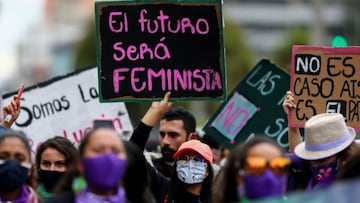International Women’s Day: meaning, origin and why is it celebrated on March 8?
First held over a century ago, International Women’s Day highlights the achievements, challenges and struggles of women around the world.

On Friday 8 March 2024, events around the world will mark International Women’s Day - a global celebration of women’s social, economic, cultural and political achievements. First held over a century ago, IWD is also an opportunity to reflect on and further the push towards gender parity.
Gender discrimination negatively impacts girls and women every day in almost every society. There are countries in which they cannot dress as they like, drive, work at night or inherit property, and do not have the freedom to choose the person they marry.
And even in a nation such as the United States, where many women’s rights are protected by law, 42% of working females say they have faced discrimination on the job based on their gender, while women are regularly paid less than male counterparts in the same role.
Sadly, despite the many years of struggle for a fairer world, the need for International Women’s Day remains as great as ever.
What is the theme of International Women’s Day 2024?
According to the International Women’s Day website, the campaign theme for IWD 2024 is “Inspire Inclusion”.
“When we inspire others to understand and value women’s inclusion, we forge a better world,” a statement reads. “And when women themselves are inspired to be included, there’s a sense of belonging, relevance and empowerment.”
The United Nations also comes up with an annual IWD theme of its own, which this year is “Invest in women: Accelerate progress”.
“Achieving gender equality and women’s well-being in all aspects of life is more crucial than ever if we want to create prosperous economies and a healthy planet,” the UN says. “However, we are facing a key challenge: the alarming $360 billion annual deficit in gender-equality measures by 2030.”
The countdown is on for #IWD2024 ⏱️ How are you planning to celebrate? How will you #InspireInclusion on March 8 & beyond? In #Brazil 🇧🇷 Gisele Britto struck the #IWDpose, joining further people across the world 🌍️ showing their support for #InternationalWomensDay ✨️ pic.twitter.com/5ytTIMAaZC
— Women's Day (@womensday) February 29, 2024
How did IWD come about?
On 28 February 1908, 15,000 women took part in a march in New York City, calling for shorter working hours, better pay and the right to vote. A year later, the Socialist Party of America marked the anniversary of the march by declaring it the first National Woman’s Day.
At this stage it was only an American celebration, but in 1910 the women’s rights advocate Clara Zetkin addressed the International Conference of Working Women in Copenhagen, and suggested that they make the event international.
Related stories
The 100 women in attendance unanimously supported the idea and on 19 March 1911, the first International Women’s Day was celebrated in Austria, Denmark, Germany and Switzerland, as well as the US. IWD remained a stand-alone event until 1975, when the UN began marking the day and organised celebrations.
In the years after 1911, 8 March established itself as International Women’s Day - a choice chiefly rooted in a mass demonstration held by Russian women on this date in 1917. The protest, which began when female textile workers in Petrograd demanded the right to vote, plus an end to World War I and food shortages, had a role in bringing about the Russian Revolution.